
**Note: My full & final in-depth review of the Grit X2 Pro is now available. Check it out here!**
Polar has just announced the latest version of their flagship watch: the Polar Grit X2 Pro. While the Polar Grit X series contains the same features as the Polar Vantage V series, it’s designed in a more rugged case and premium materials. Except previously, that adventure-oriented Grit X series lacked one important backcountry feature: Offline maps.
Now that box is checked, along with a slate of other features coming to the Grit X2 Pro that were introduced on the Vantage V3 last fall.
The Grit X2 Pro adds those global offline maps, adds dual-frequency GPS, an improved heart rate sensor, and of course – an AMOLED display. Thus cementing Polar’s fast-paced transition from MIP to AMOLED displays, along with the rest of the industry. However, Polar is also adding in a bunch of new software features to both the Grit X2 Pro and Vantage V3, including Strava routes support, vertical speed, VAM, 3D speed, and historical track display. Plus, they’ve massively overhauled the algorithms behind the new gen4 optical HR sensor since last fall to try to address issues.
I’ve started putting the Grit X2 Pro through its paces, though this isn’t an in-depth review yet. Polar says the firmware for this watch won’t be final for another few weeks. Thus, I’ll be taking that time to push this watch (and me) to the limits and see if it can hold up on some very legit (and probably very painful) adventures. After which, I’ll post my full in-depth review. Given the Grit X2 Pro won’t start shipping till April 3rd anyway, the timing should work out just fine.
With that, let’s get into it!
What’s New:

The definition of ‘new’ will depend on which previous watch you’re referring to. If comparing it (logically) to the Polar Grit X Pro (released in 2021), then there are a number of very substantial changes, outlined below. Whereas, if you’re comparing it to the Polar Vantage V3 released this past fall, there are precisely zero feature differences. Which I also explain down below.
First up, here’s what’s new compared to the original Polar Grit X Pro:
– Changed to 1.39” AMOLED display (326ppi, 1,050 nits)
– Maintains sapphire crystal glass
– Increased display size by 15% (versus GRIT X1 Pro)
– First Polar watch to have 810H durability mil spec
– Increased processor speed by 129% vs GRIT X1 Pro (275Mhz processor)
– Added dual-frequency/multiband GNSS/GPS
– Redesigned GNSS/GPS antenna
– Increased storage to 32GB (mainly for maps)
– Includes North America & Europe maps downloaded (and free downloadable maps for everywhere else)
– Changed Polar charging cable to USB-C (still magnetic on watch side)
– Added Strava Routes syncing (finally! Also coming to all Polar route-capable products)
– Added historical track/route on navigation map (previously only showed planned route)
– Added Vertical Speed and VAM (Average Ascent Speed)
– Added 3D speed (how it calculates speed in steep situations)
– Upgraded to Polar’s 4th Gen optical heart rate sensor + ELIXIR (same as Vantage V3)
– Added heart rate ECG functionality (Note: Does not include Afib detection)
– Added nightly skin temperature
– Added skin temperature tracking feature and baseline/guidance
– Added new optical heart rate backdated error correction feature (fixes bad HR data in realtime)
– Added two new watch faces since Vantage V3 (one analog, one digital)
– Added virtual flashlight (display based)
– Battery life increases to 43hrs of GPS training mode, or up to 140hrs in eco training mode
– Maintains 100m water resistance spec
– Maintains temp range of -20°c to +50°c
– Maintains stainless-steel front case, and plastic back case
– Two base model colors (Night Black & Stone Gray), and one Titan Edition
– Price increases from $/€529 to $/€749 for base edition, and Titan edition from $/€649 to $/€869
Note: Titan edition includes a secondary leather strap, and has a total watch+band weight of 64g.
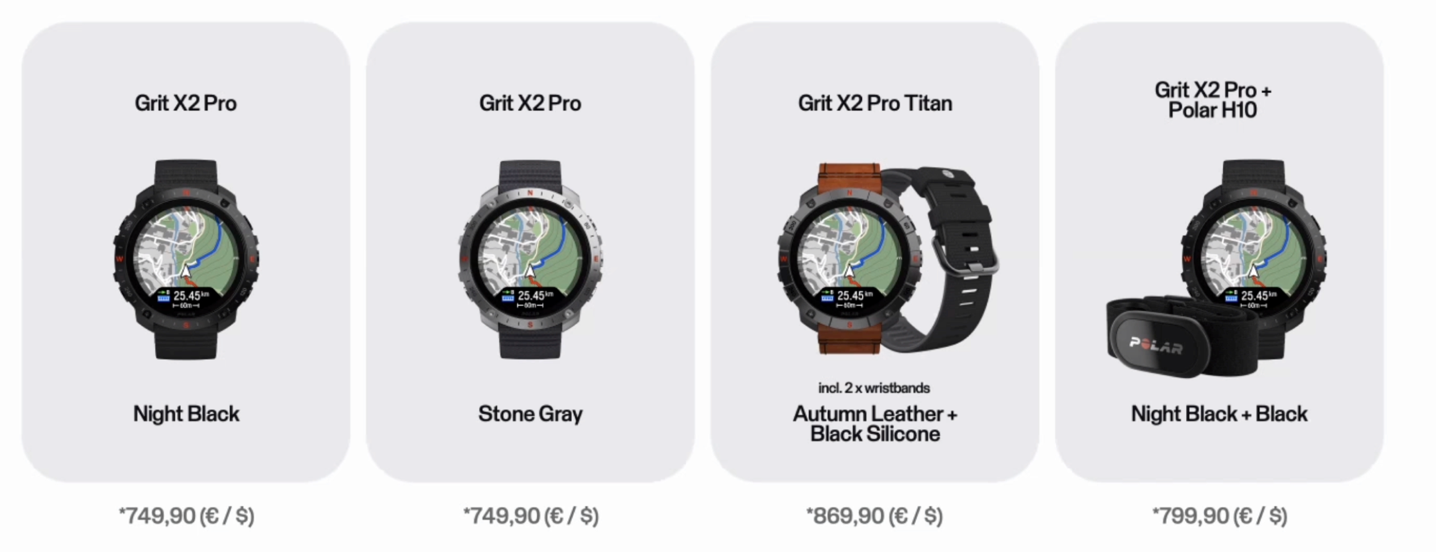
Now, you may be wondering how this watch differentiates itself from the less expensive ($599) Polar Vantage V3. And the answer is simple: Purely based on external case design. That’s it. The two watches run the same exact software, have the optical HR sensor, the same GPS chipset, and even the exact same battery inside. In fact, the Polar Vantage V3 will get a software release (v2.0) the same day the Polar Grit X2 Pro starts shipping (April 3rd), that’ll ensure both watches are lock-step identical when it comes to features. So to reiterate: Yes, the Vantage V3 is getting all these same new features
When it comes to material differences, they are as follows:
– Grit X2 Pro has a different external case design/look
– Grit X2 Pro has 100m water resistance, versus 50m for Vantage V3
– Redesigned external GPS antenna design, specifically for the Grit X2 Pro
Note that antenna designs would be different anyway between the Vantage & Grit X series, since the case designs use different materials. These days, the GPS antenna is arguably the most important component when it comes to GPS accuracy. Over the last few years we’ve seen countless examples of two different watches using the exact same GPS chipset, but different antenna designs. So much so that *both* Polar and COROS have made a point of publicly stating their first attempts at dual-band GNSS antennas on previous products (COROS Vertix 2 & Polar Ignite 3) led to not-awesome GPS results.
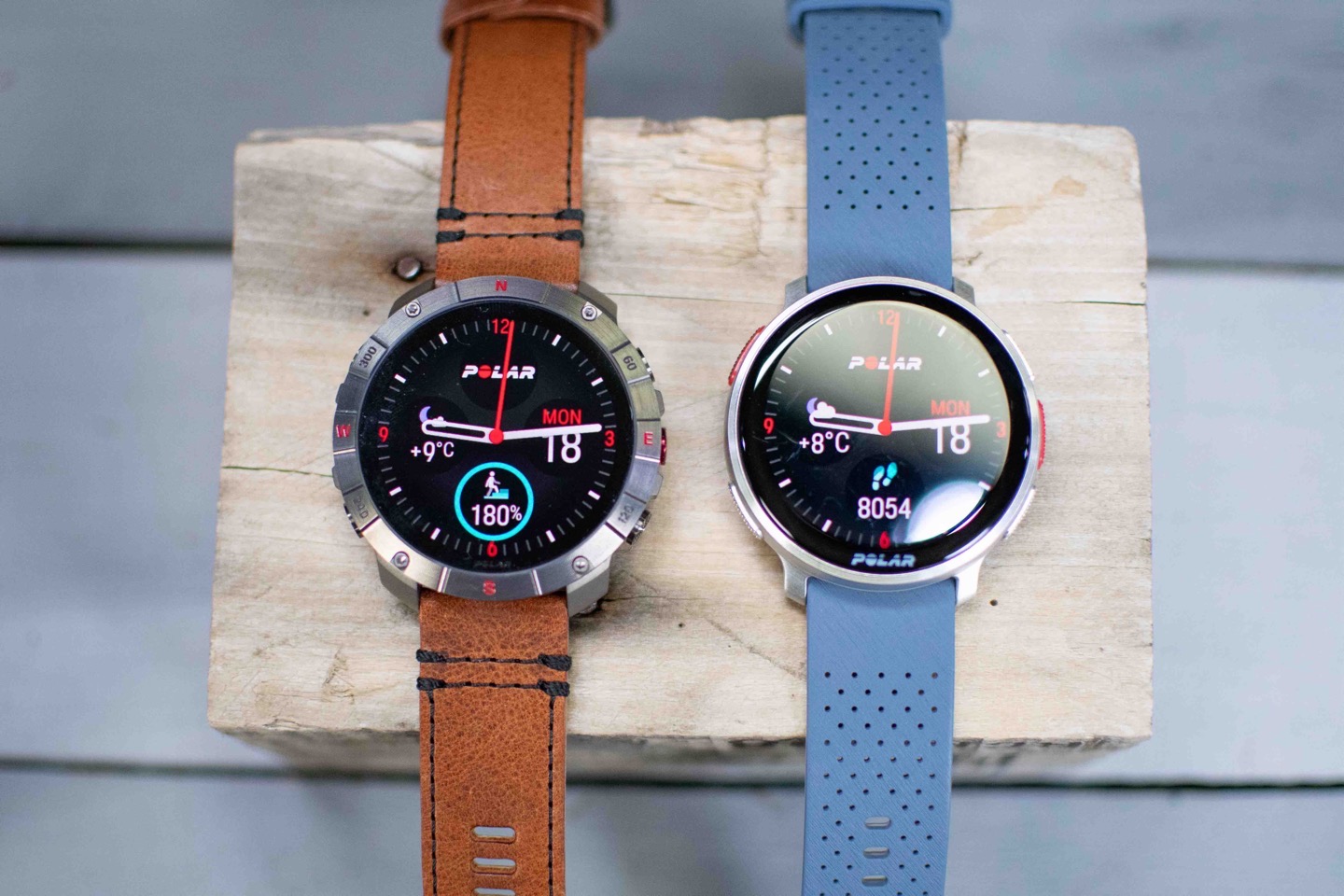
Thus, Polar made a point in their media presentation of calling out continued refinement on their GPS antenna design. Obviously, that’s something I’ll be looking very closely at in my final in-depth review, across some very challenging mountain terrain, as well as challenging cities – and of course empty farm fields too. The Vantage V3 results were so-so, though, so far the Grit X2 Pro results seem a bit better, and roughly in the ballpark of other watches I’ve been testing against (Suunto Race, Garmin Epix, COROS Vertix 2) – but plenty more testing is still required.
A Closer Look at the Hardware:
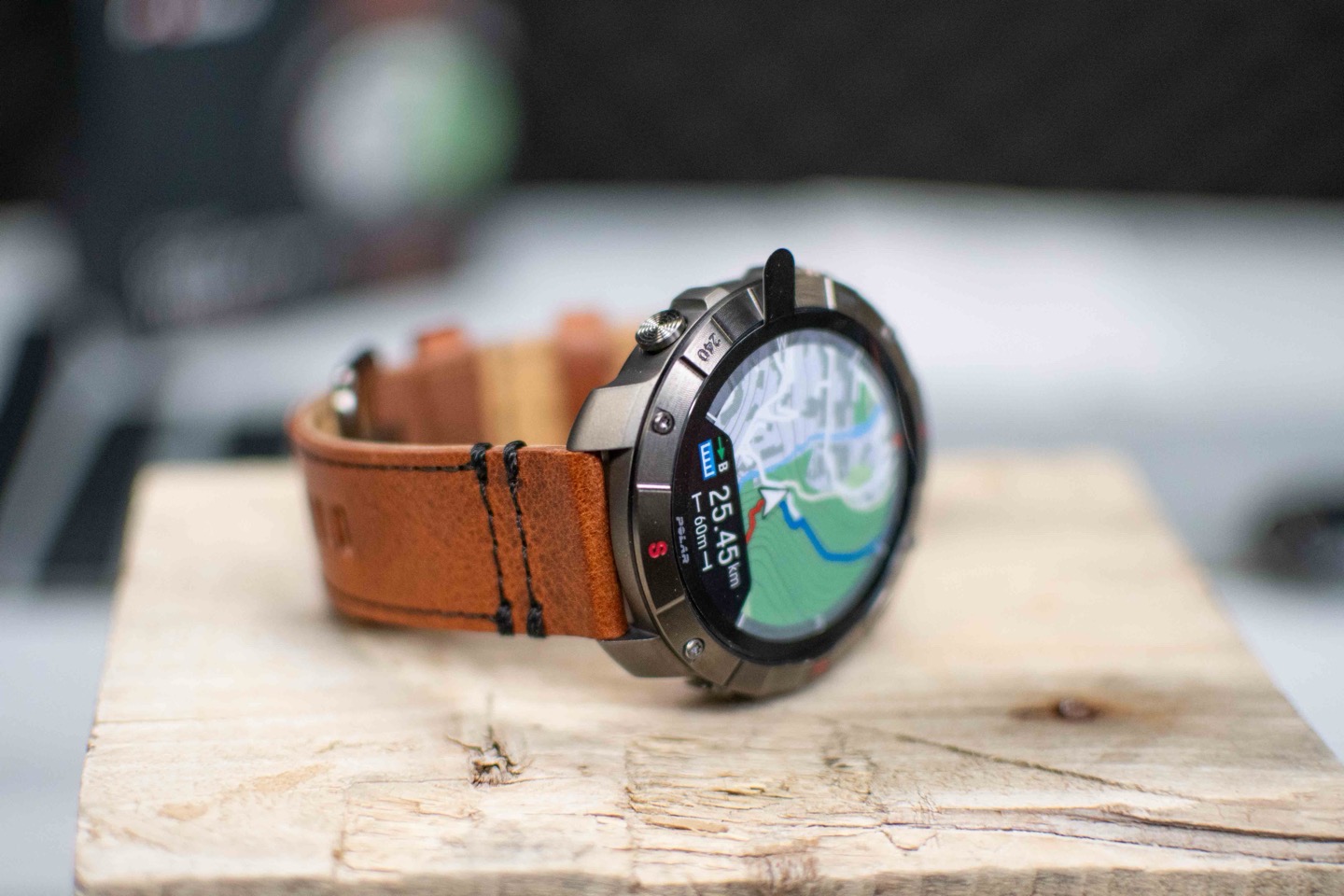
Starting off with the hardware, Polar has now completed their transition at the top-end of their watch realm, by moving from MIP to AMOLED. This 1.39” touchscreen is exactly the same as the Polar Vantage V3. That’s a good thing, as I found that screen (and this as well) very easy to see in all lighting conditions, from bright sun, to running at night.

With that, they’ve brought in the virtual flashlight feature as well, which lets you toggle on/off using the screen as a flashlight. That too, is more than bright enough to light up a hotel room/bathroom at night. I suppose this feature belongs down in the software side of things, but since it’s tied to the AMOLED display, I’m leaving it here.
Meanwhile, on the back of the unit they’ve transitioned to Polar’s Gen4 optical HR sensor (same as Vantage V3). This improves accuracy compared to the previous iteration, but also brings in nightly skin temperature tracking as well as ECG recording capability.
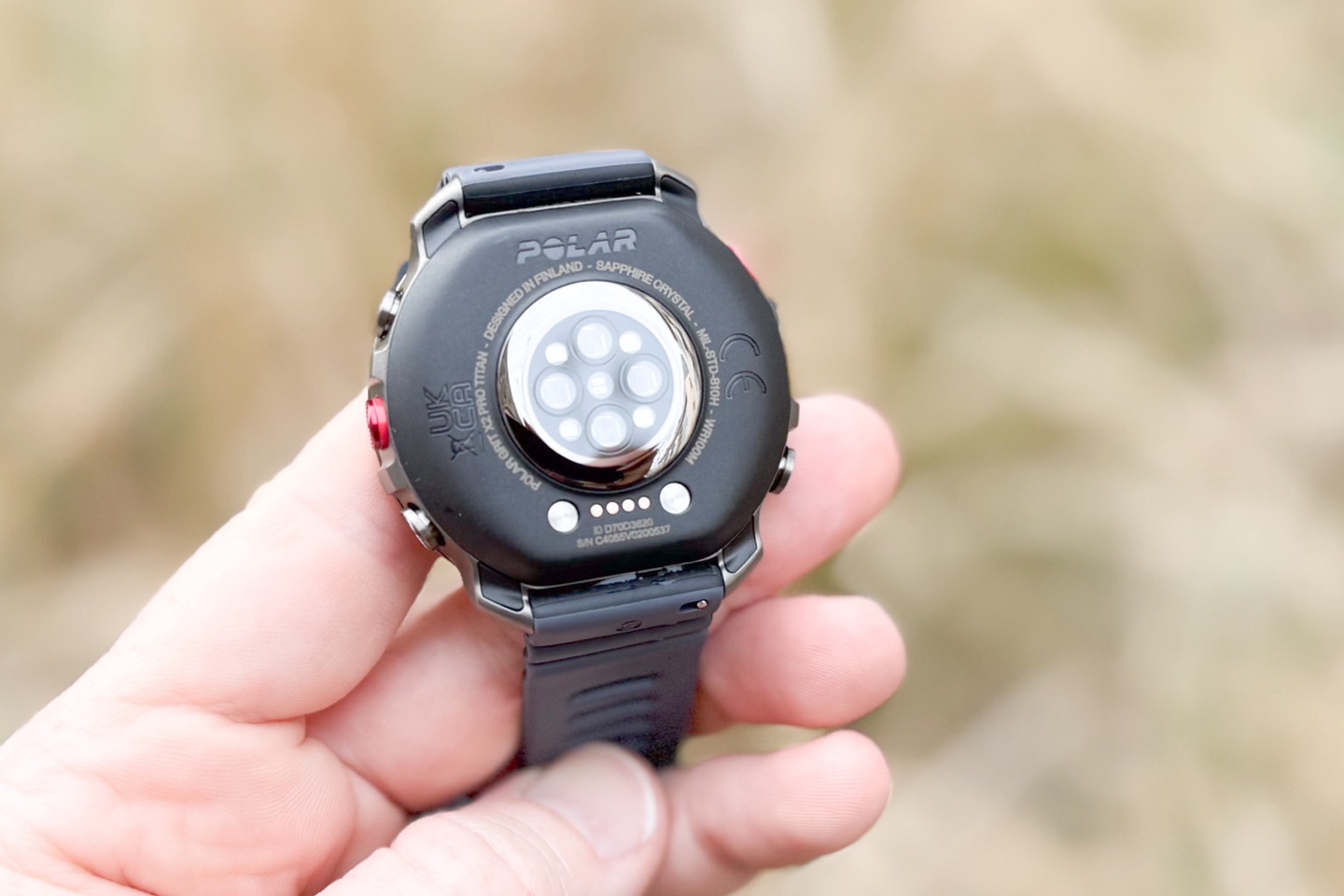
In the case of the nightly skin temperature tracking, you’ll see that displayed both on the watch, as well as within the Polar Flow app. As with the Vantage V3, it’s showing the difference to your baseline – it doesn’t show the exact temperature. This is how most wearables work as well.
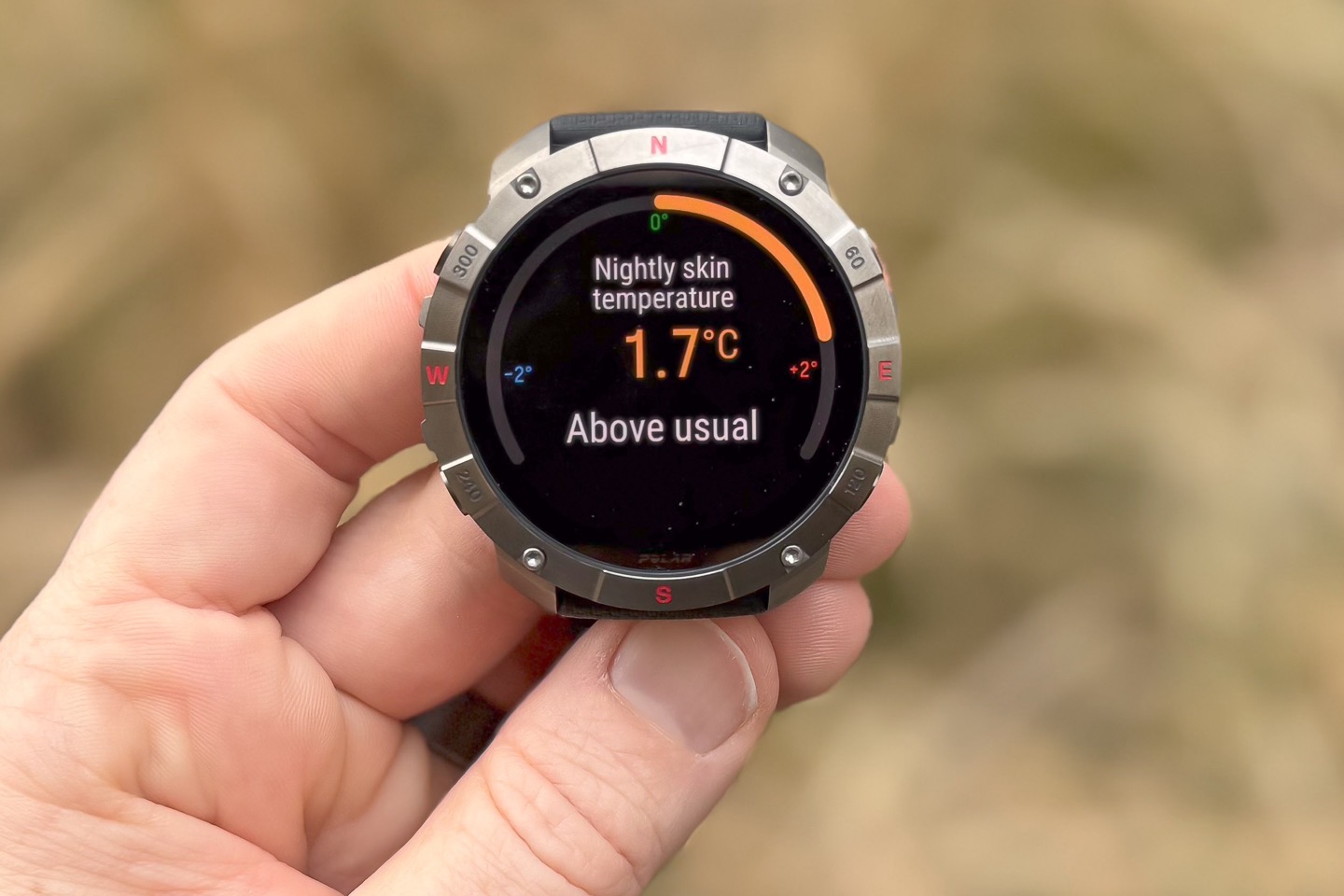
And with the ECG feature, it’s merely showing an ECG trace, that you can manually take. It does not detect Afib or other conditions, nor is it FDA-approved from a medical standpoint. Instead, it lets you record that short moment in time, and then export it out as a PDF to share with doctors later.

Now Polar made a note of pointing out that they’ve added 20,000 lines of code to the heart rate algorithms since the Polar Vantage V3, in order to improve accuracy (which wasn’t great). Within that, they’ve added a new feature which will retroactively correct your historical HR data on the watch in realtime, when it detects something went wrong. So imagine you’re doing intervals, and after the first interval you clearly see the data is wrong. Polar says that it should automatically detect that failure, and then correct the historical data.

What’s interesting about this is that it’s actually something I can show/demonstrate, because Polar also has a heart rate broadcasting feature. So on my workouts I’ve been dual-recording both to the watch itself (which would have the corrections), but also to a secondary device/app (which wouldn’t have the corrections). To date I haven’t been able to de-couple them yet.
Additionally, Polar says that their heart rate algorithms won’t be final until April 3rd, and thus I’ll wait for my final review to give the verdict there. At this point though, I’m seeing some improvements over the Vantage V3, though not industry-leading performance yet.
Finally, as noted above, there are two variants of the Grit X2 Pro – a base model and the Titan edition. The features are identical, however there are material differences in the case design (stainless steel versus titanium). Moreover, the Titan edition comes with an additional leather band. And that leather strap looks absolutely fantastic.
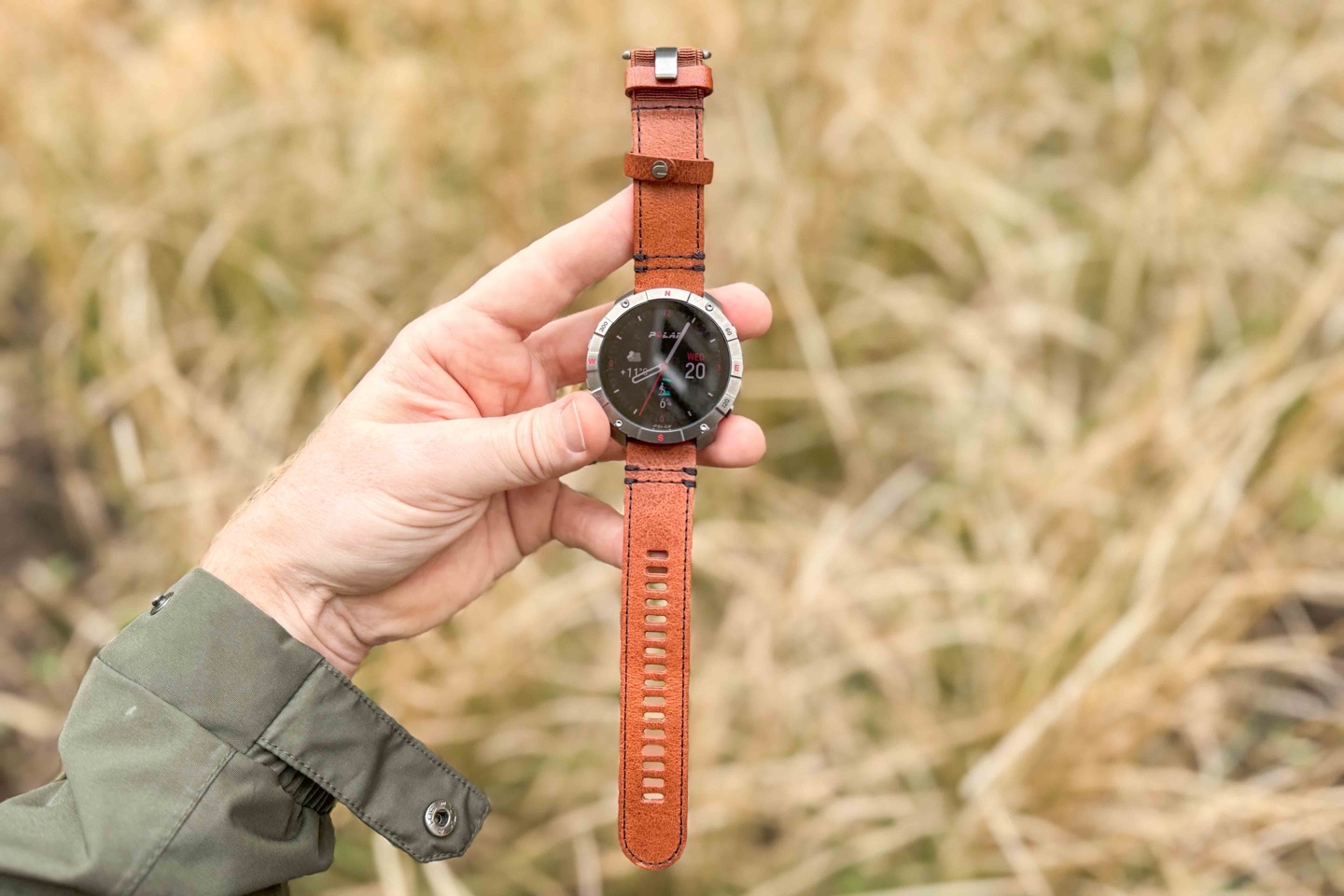
With that, let’s dive into some of the software features.
The New Software Features:

The first big feature compared to the previous Grit X Pro is the addition of offline maps. The unit is loaded with a basemap of both North America and Europe, and then you can download other maps for the rest of the world free from Polar’s site. In addition, you can download a more detailed set of maps (also from Polar’s site for free), which take up more space, but give added detail at lower zoom levels. Doing so takes just a few minutes.
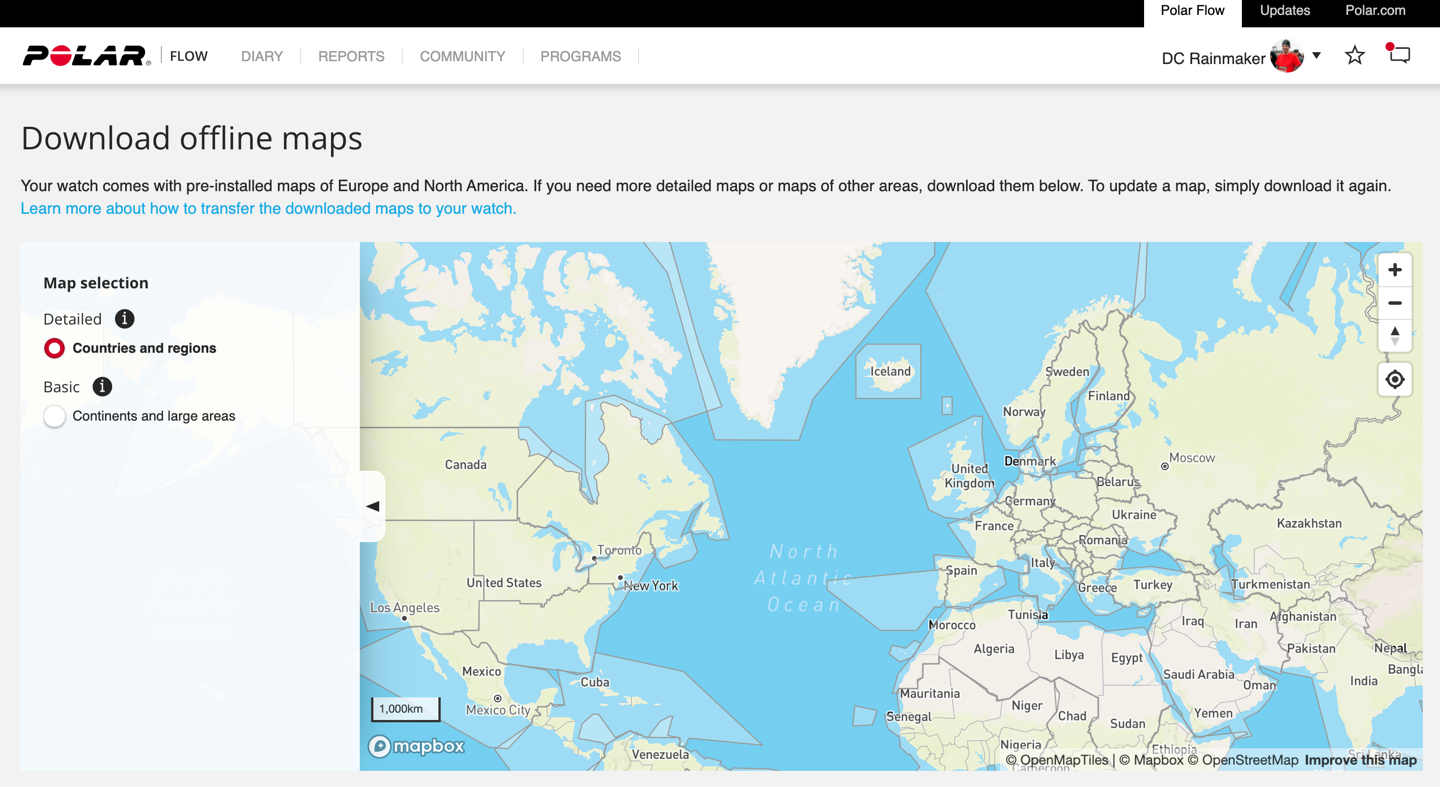
When it comes to the detail level in the maps, Polar says that they’re looking at adding more POI/street/landmark/etc labels/names down the road, but don’t have a specific timeframe for when that might happen.
No matter which detail level variant you use today, you’ll now see the map during your GPS workouts, and notably, with the new software update (also coming for the Vantage V3 on April 3rd), you’ll see your historical track as well. This is a much appreciated update, as the Vantage V3 didn’t launch with that, which was kinda wonky if you had gone off-course, you couldn’t see where you came from to backtrack a bit.

Additionally, starting today (yes, today), you’ll now be able to get your Strava Routes synced to not just the Polar Grit X2 Pro, but every Polar route-capable watch. This sync works in much the same way as Komoot, to push favorited/saved routes to your Polar Flow account for syncing to your watch.
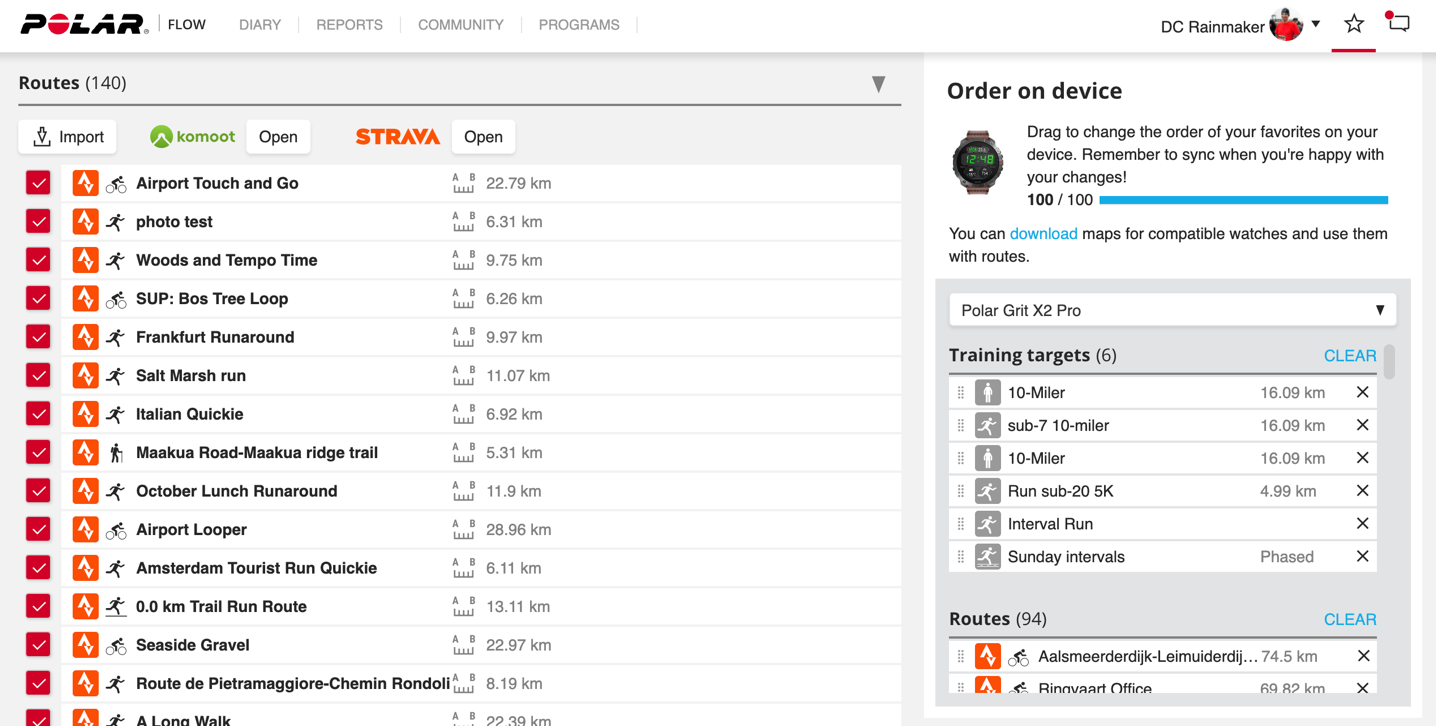
However, it won’t contain the turn-by-turn style implementation of Komoot, instead, it’ll be akin to importing a GPX file in, where it’s breadcrumb style routing only.
Once out doing your GPS activity, you’ll now see two new data fields: Vertical Speed & VAM (which is essentially ascent speed). Additionally, the unit will calculate 3D speed now, which gives you slightly more accurate speed/distance measurements in steeper ascents/descents. You won’t see a separate 3D speed field, but rather, it’s just doing that calculation automatically.
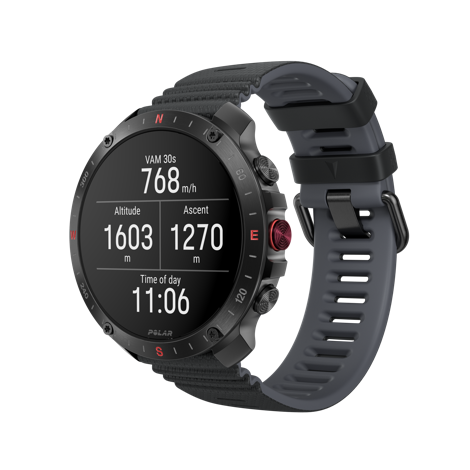
Finally, there are two new watch faces (compared to the Vantage V3), and those watch faces will also be available for the Vantage V3 too. There’s one digital one, and one analog one:
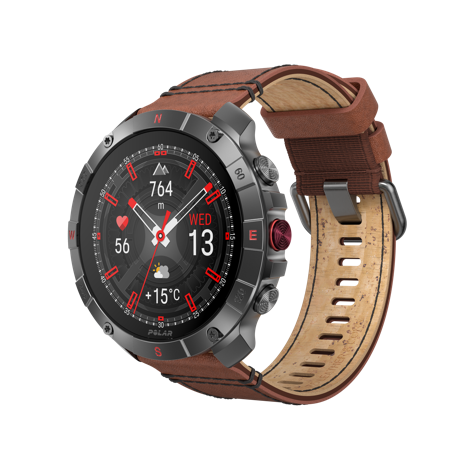
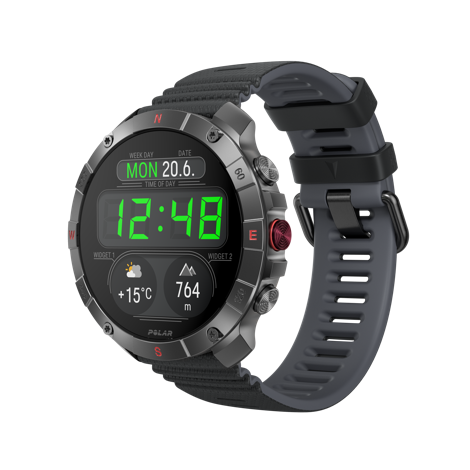
Again, Polar’s stated goal is that the Vantage V3 & Grit X2 Pro remain identical feature-wise.
Going Forward:

Obviously, it’s a bit too soon for an in-depth review, or for final thoughts. Starting from the tech side though, what Polar’s doing makes a lot of sense. To streamline the software for both the Vantage V3 and Grit X2 Pro into a single identical/cohesive software version is what a lot of people have asked for, both from Polar and other companies. So it’s good to see Polar delivering on that. Likewise, it’s nice to see additions like Strava Route support coming to not just these two watches but Polar’s entire lineup of route-capable watches.
Nonetheless, with the Vantage V3/Grit X2 Pro having identical software and identical internal hardware components, the only difference becomes the external case design/style (and the added leather band for the Titan version). While it makes sense to have a premium for that case design compared to the Vantage V3, I struggle (immensely) to see how a 50% price increase compared to the existing Grit X Pro is justified. But more importantly, I simply don’t understand how a $750 price is even fathomable when compared to any of their competitors. There’s really no other way to say it.
At $750/$869, I simply don’t see how Polar aims to attract new customers to their brand/platform. Obviously, they’ll convert some of their more ardent fans, but the features Polar has in this product make that price point immensely challenging (even if it had perfect accuracy/performance). Nonetheless, I’m interested in seeing how it performs in harder conditions over the coming weeks – so stay tuned for that!
With that, thanks for reading!
Found This Post Useful? Support The Site!
Hopefully you found this review/post useful. At the end of the day, I’m an athlete just like you looking for the most detail possible on a new purchase – so my review is written from the standpoint of how I used the device. The reviews generally take a lot of hours to put together, so it’s a fair bit of work (and labor of love). As you probably noticed by looking below, I also take time to answer all the questions posted in the comments – and there’s quite a bit of detail in there as well.
If you're shopping for the Polar Grit X2 Pro or any other accessory items, please consider using the affiliate links below! As an Amazon Associate I earn from qualifying purchases. It doesn’t cost you anything extra, but your purchases help support this website a lot.
Here's a few other variants or sibling products that are worth considering:
And finally, here’s a handy list of accessories that work well with this unit (and some that I showed in the review). Given the unit pairs with just about any Bluetooth Smart sport sensors, you can use just about anything though.
And of course – you can always sign-up to be a DCR Supporter! That gets you an ad-free DCR, access to the DCR Quarantine Corner video series packed with behind the scenes tidbits...and it also makes you awesome. And being awesome is what it’s all about!
Thanks for reading! And as always, feel free to post comments or questions in the comments section below, I’ll be happy to try and answer them as quickly as possible. And lastly, if you felt this review was useful – I always appreciate feedback in the comments below. Thanks!




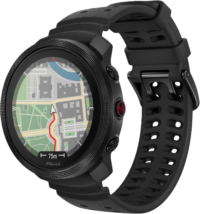
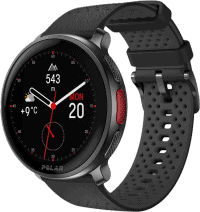
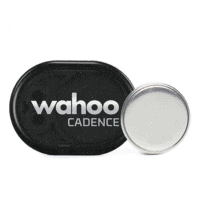
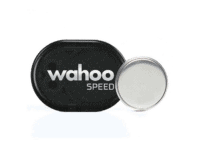

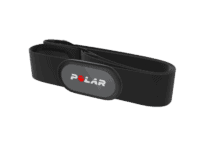
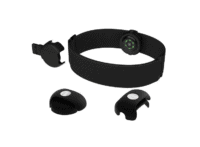

















You don’t mention the offline maps as being routeable on the watch, so I assume they aren’t?
Unfortunately not…
Correct.
I’m really after some capability to create new routes on the fly (from my mobile would be acceptable) and send to the watch all without an internet connection. Any idea whether this can be done using an offline (premium) Komoot subscription, i.e. create route in Komoot and sync to the watch all while completely offline?
I assume that’s a step too far. I’m not a fan of the Garmin look – so searching for a viable alternative!
No, it requires internet to sync.
Yeah, I thought that might be the case. Same with Suunto. The only brand I can find that supports offline route creation via a mobile and syncing to the watch is Garmin using Garmin Explore.
Offline maps alone is enough for me to upgrade, but also the design looks really nice
Polar’s pricing strategy is weird to say the least. This watch is still inferior compared to Fenix 7/Epix series and it costs even more… how do they exactly want to compete in the market? perhaps they don’t want to? it’s mind-boggling.
Still only 4 data fields per screen…
Worth saying that the sapphire glass is also a different feature to the V3. Nice to see they listened to you RE historical track and Strava routes! Still annoying that turn-by-turn is still locked to Komoot though.
Hi Ray,
thanks for the link to the route! While I’m not runner enough to run it, I’ll definitely look at it from the hiking perspective.
Is the OnePlus Watch 2 in your review pipeline?
Not that I am interested in buying it, but the technology and battery life seems interesting.
Looks like delivery/availability still isn’t till early April or so. I’m keen to give it a whirl, but don’t have a unit at this point.
With Ray I was thinking about the price ‘”… the features Polar has in this product make that price point immensely challenging)”. Indeed, comparing it to competition with similar products, it seems odd. But not if you see the Polar Grit as an ‘upgrade’ for the Polar Vantage. If you want an upgraded case with your Vantage, pay extra. That makes sense, at least to me.
Because the Polar Vantage price point seems not that odd, compared to competition (e.g. Garmin 965 for € 650,-). Although you might always argue it is too expensive for what it offers (I do) but that is rather subjective.
And why the Polar Grit compare to e.g. a Garmin 965? That should then be compared with the Polar Vantage, not the Polar Grit.
I am thinking Polar might have adopted that kind of reasoning… does that make sense?
Yeah, I totally get how Polar got to this price, when using the Vantage V3 pricing as the assumed baseline.
The problem with that logic, is that the Vantage V3 is widely considered to be overpriced. If we work our way back from the Garmin FR965 as the price baseline there in that category ($599), it’s incredibly difficult to justify the V3 pricing, given the massive feature gaps (or even accuracy gaps), that exist between those too.
I think the Vantage V3 is really a $499-$529 watch, in a best case scenario. That’s why so many people have looked at Suunto and the Suunto Race as a very interesting option.
The problem with $750 for the Grit X2, is you’re up against the Garmin Epix (not-pro) at that same price not on sale, which again, easily beats it on features/accuracy/etc. And that’s ignoring the fact that the not-Pro Epix is still getting new feature updates, on sale about every other week for substantially less, etc…
I like the Grit X2 as a watch/etc, but just think they simply missed the price (hugely). If you can’t compete on features, accuracy, or materials – you *HAVE* to compete on price.
> Garmin FR965 as the price baseline there in that category ($599)
Not to mention the 47mm Epix 2 Sapphire (not pro) is currently also priced at $600.
What do you see as the main feature gaps between the Grit X2 Pro and either the FR965 or Epix beyond possibly the mapping capabilities?
We’re realistically talking hundreds and hundreds of features as the difference here. I’d guess on the order of 500-700 features between Epix and Grit X2 Pro.*
The problem is it’s easy to say “Look, they both have maps” or “they both track a run and have running power”. But once you get beyond the basics that everyone does, there’s just endless numbers of tiny features. In navigation/hiking/etc there’s ClimbPro, there’s Up Ahead, there’s a slew of additional climb related metrics. There’s trail names, POI’s, Round Trip Routing, trail junctions, etc… I mean, I’d guess at least 50-75 different navigation features alone if one were to type them all out.
If we look at running, it’s sorta the same thing around things like PacePro, or Run/Walk time, or Running Track mode, specific run-suggested workouts, or, or, or…
And that ignores features like daily health/etc tracking features, training load type features (Polar has some, but they’ve stagnated for years now), etc…
Of course, some folks will dismiss these features saying they never use them. But that’s actually Garmin’s secret sauce: People do use them. They just don’t use *ALL* of them. But they use certain ones, and they use that specific feature a ton. Each person has their own specific features. In total, it’s all these little features that add up.
*One only has to look at my recent FR165 vs FR265 to see how quickly that list adds up on two very similar Garmin watches: link to dcrainmaker.com
The Epix vs those watches, or Epix vs Polar watches would make that list look like childsplay. Even Polar & Suunto will readily admit they can’t win on features versus Garmin. Which is why you see Suunto undercutting on price, and adding a bit of style in that price ballpark (Suunto Race). And why you see COROS packing in the features at the low-end for the COROS Pace 3.
I’m okay with not having those features. But the main difference is the battery life here. From some reviews, I see that Epix Pro with Always-On display should survive 6 days and Grit X pro only 2 days (info from their website) (I want to have it always on and don’t even look at the option to turn this off
I was about to hit the “buy” button but then looked at battery life and am now reconsidering this…
my bad, I selected a Training Mode to see battery life, it is the same as old version should survive 5-7 days
This is exactly why I have not seriously considered moving away from Garmin. There is simply no point. None of the Suuntos, Polars, Coroses, named whatever, comes remotely close. Yea, the Epix Pro 51mm is seriously expensive, but you get SO many different components with it. I use the POIs, I use navigation, I use track back, I use ClimbPro, the suggested workouts, Track running, the list goes on.
I tried the Race for a couple weeks, it felt like a dumb watch, yea the GPS tracking is good, but the usability vs my Epix, there is no contest.
When I look at comparing watches, they run out of features when the Epix has a couple pages left. It’s really sad, because yea I would like to try out different brands but it’s just not worth it.
If you hike and trail run in remote areas, run, cycle, dive, swim, there is just no other watch that comes close. The amount of times the routing on my watch saved me hours on trails with crap markings (really, why add maps if you’re not going to bother with trail names?!) is worth the (not even that big) premium you pay.
That is actually not true. Look closer. Always on gives you 5 days.
Thanks for the response and also to bob and nicolaas’ responses as well.
Guess I’m gonna hold out for a bit and then probably buy a Garmin once I see whether there’s a new Forerunner 9xx or Fenix 8 out at some point later in the year.
I want to bring in the Garmin MARQ collection.
Garmin is offering a watch (MARQ) with less functionality than an Epix Pro but with a much higher price. Garmin is requesting the higher price only because of the watch case.
When comparing the watches based on the case material, should the Polar Grit X2 be compared to the Garmin MARQ?
The device has because of the bezel a very rustic look. For a 24/7 wear it is too rustic and old fashioned for me.
I also found it a remarkable combination, that rustic bezel style with the shouting, colorful, shining AMOLED display. Like fluo sneakers with brown leather strings and a brown leather sole…
Totally agree on your comment about the price point. Who is the target market for this watch? $750 is the price of the Apple Watch Ultra 2 right now.
I really like the design, same way I prefer the design of the Fenix over the Forerunner. There’s a good chance a lot of Polar customers would be willing to pay $50-100 extra for that. But $750 compared to $500 sounds ridiculous to me.
> $750 is the price of the Apple Watch Ultra 2 right now.
I am willing to pay more to have the ability to not have Apple smart features, you can’t use Apple Watch as a
“dumb” watch
I am not sure if 20k of lilines of code means it’s greatly improved…
I can generate you 20k lines of code with many nonsenses and bugs compared to a well made 5k lines code base.
(but they seemed very eager to mention it to you so :))
had the same thought. that often long code means a lot of work-arounds and tweaks instead of doing it right))
Better comparison would be the accuracy metrics vs reference device, before and after the fix…
Yup, that’s something I’m specifically looking at (accuracy changes). As always, I don’t really care much what any company says from a marketing standpoint. The only thing that matters in my review accuracy-focused sections is whether or not it’s actually accurate.
An area I’ll dive into with more testing.
Owning a Grit X for a few years, I wonder if Polar will finally take care of two known issues that are bugging me severely:
– the need to calibrate the compass manually even during workouts when using the routing function
– the watch not being able to adjust the actual height by itself. Polar is suggesting to restart the watch if you want the height recorded correctly.
It isi insofar nice to see that Polar brings an interesting new product to the market. But – having the customer service in mind that fails to deliver on product improvement for years – I see not much reason for not turning to Garmin with the next watch.
These are really nice looking watches. If I weren’t so invested in the Garmin ecosystem, I would definitely consider this watch. The heart rate correction algorithm seems really cool too. I wonder how well it works in practice?
When AW Ultra gets routable maps and proper routing during an activity, I don’t see why anyone would buy this device.
Anyone who doesn’t have an Apple phone.
Hello Ray,
is it possible to recharge the watch during an activity.
Not at this point.
I’m looking forward to the Vantage V3 firmware update and hopefully that will fix some issues I have, as well as adding trail breadcrumb.
As for Komoot: Is the push only one way, that is, from Komoot to Polar Flow? I don’t want to upload my runs to Komoot.
From link below the sync goes both way: link to support.polar.com
I feel like the polar marketing meeting went something like this:
“So Garmin is killing us in this market, we need to make something like the Epix Gen 2.”
“So it’s going to have all the Epix Gen 2 features?”
“Well, yeah, at least on paper, but they’re not really going to work as well.”
“Oh. But people won’t mind because it’s going to cost less, right?”
“Well, I guess we could charge less, but hear me out. What if we actually charge more for it.”
The really tough compare for the Grit 2 isn’t with the most-similar hardware spec 51mm Epix Gen 2 sapphire titanium. That compares at Garmin $1,200 vs Grit 2 (now reasonable-sounding) $870.
The tough compare is the 47mm Epix Sapphire which is marked at $600 on garmin.com right now.
Ray, you are so far the only early reviewer of this watch that doesn’t list the display-torch as a separate torch…Thank you. Seems like those reviewers really want it to be on par with the Epix line.
This thing still comes nowhere close to my Epix Pro, and also looks like it was released about 5 years too late looks wise… and here I got all excited about a possible Epix alternative.
While I obviously prefer a built-in LED flashlight in terms of usability, I will give Polar credit that their virtual flashlight is seriously bright AF. Like, beyond bright. It easily illuminated my hotel room and hotel bathroom last night.
I think with some minor tweaks, they can make it a lot better by offering a hot-key (ala double-tap or such), and 2-3 levels of brightness. It’s really the practical nuances of enablement that differentiate Polar vs Garmin here, not actually the hardware itself. Thankfully, that’s easy stuff to fix – but convincing companies to invest in these nuances can be surprisingly hard.
While I don’t doubt that the screen is bright, it annoys me when reviewers make inaccurate statements and deceive people who don’t pay as much attention to detail. There is only one brand witch a dedicated torch, the Garmin Pro series. This does the same thing my Fenix 6 did, use the screen as a light. Nothing new, nothing to differentiate it from anything but its mediocre former version.
Yea the double click and on-the-fly brightness adjustment that came to the Pro series recently is such a fantastic usability increase and it increased my flashlight usage, haven’t reached for my phone in weeks.
I was fan of Polar but i am not buying it anymore. I had several button issues with latest models (grit x two times) and Polar did not answer any of my emails.
For years I’ve been on the verge of getting a watch from Polar or Suunto. But 2 things have always stopped me from actually doing it. I want a large screen (1.4 inch): Finally both Suunto and Polar have a suitable product with Amoled. The second point is that I want to have more than one alarm on the watch. Both manufacturers continue to fail on this small point, or is it different now with the Grit X2? The specifications only say “alarm clock yes”
Just checked on the V2.0 firmware (which applies to both watches), currently just one alarm clock.
Cheers!
Suunto 9 Peak Pro actually got multiple alarms as part of the 2.30.32 update in November 2023.
Ahh, good catch on Suunto. I was referring above to the Polar side (both watches being Vantage V3 & Grit X2 Pro).
It’s fascinating to see how Suunto and Polar are approaching the elephant in the room, Garmin. I believe they have both admitted they can’t compete with Garmin on features so logically you would have to find other avenues to present value to the customer. The Suunto approach seems, so far, to pressure them on price. I’m still trying to figure out Polars angle, this is perplexing and this is coming from a Polar owner and fan /shrug.
How’s amoled dimming handled here? Similar to the vantage 3?
Seems to all be the same as the V3.
“The Vantage V3 results were so-so, though, so far the…”
Did you write that on purpose to mess with every non native speaker trying to read that out loud? :-D
I prefer to think of it as edumacation.
Conceptually, I don’t love this idea of retroactively “fixing” oHR data to be closer to what it “probably was” as a way to deal with oHR sampling issues. This tends to reinforce for me that if you are serious about HR training, you need to capture it with an external strap regardless of the watch manufacturer.
One thing that Polar and Suunto are doing well is industrial design. This Grit 2 case design looks almost to the level of the Garmin Marq Adventurer gen 2.
Is this thing manufactured in Finland like the Suunto Vertical (which would tend to justify some the cost)?
Battery life seems decreased (compared to grit x pro 1) when always-on display and OHR 24/7 tracking is enabled from ~7 to only ~2 days?
this is not a training mode ^ , just regular usage
That’s showing sports mode. It’s definitely far more than 33hrs in always-on display mode. It’s Thursday early evening now, and I haven’t charged it since 6AM Tuesday morning, and I’ve been in always-on display mode, with multiple workouts, and it’s at 58% (and that includes a bunch of filming time too).
oh yes, you are right!
it is the same as the first version
Thanks to common sense the output of the ECG is NOT evaluated!!!
Honestly, I would never thought thta Ray will be the one who doesn’t know how to wear a sport watch while gathering an ECG…
In the case of the one channel-one lead ECG the purpose is to gather the main channel II from a 12-lead ECG.
Wearing the device on a right hand would result a kind of aVR channel from a 12-lead.
If some evaluation algorithm is set up to evaluate the channel II and it is evaluating the aVR instead you can result as STEMI based on the ST elevation…
…so wear any device capable of ECG on the left wrist!
“Honestly, I would never thought thta Ray will be the one who doesn’t know how to wear a sport watch while gathering an ECG…”
Because you don’t.
Not a single company requires you wear it on one wrist or the other. Neither does the FDA certify it on one wrist or the other. In fact, that’s actually why all these companies literally ask you which wrist you wear it on – to account for that in the readings. The ones that are FDA certified, even do it as part of the first time usage of the ECG feature.
Is this made in Finland and carbon compensated like the Suunto Vertical? Otherwise I have no idea why any should pay 750€ for it while there is a Suunto Race. You can also easily grab a new Epix 2 sapphire non pro folr around 550€in Germany. So who should buy this watch?
No, Theo own their own factory in Guangzhou in China, where serial production units are manufactured. Pre-production units are produced at HQ in Finland.
I know Ray disagrees strongly with this, but really a big BOO for there only being an OLED option, especially for an outdoor watch. MIP is still better overall for that.
I don’t mind OLED being an option, as Garmin essentially do, but forcing it is not welcome (here at least).
Lookin forward to the full review! …will probably be my next Polar.
Was looking forward to this announcement. But then I saw the price. I laughed and then promptly ordered the titanium Suunto Race. Pretty sure Suunto’s sales went up on March 20 after the Grit X Pro 2 was announced.
Now that Polar put their new watch to the market I’m curious what Garmin would bring with their new Fenix. Does it kicks their ass or has Polar developed their watch quit good. What would you think @dcrainmaker what en when the new Fenix will bring.
Hallo Ray,
What a beautiful watch. The polar Grit X2 Titanium. Just 53 grams. Comfortable. Good looking. It will definitely do the job and record my runs and other stuff well enough.
It’s the looks, the feeling, the comfyness that matters. Not if it’s 1% or 5% off. The joy that comes with looking at this beautiful piece of art is what triggers you to use it and go for a run.This is a cult watch. A brand whit history. These watches are collectors items. Like the first Polar heart rate watch.
I will definitely buy one.
I wish they had used the same style of bezel for both, as I find the smooth SS one much nicer and more classy looking than the bulges on the Titanium version. If I were to get one, I would go for Titanium solely because of weight, but the look puts me off.
Can anyone tell me if Polar Vertical Speeds is the same as Grade Adjusted Paces from others? Thanks.
I bought the Grit X2 Pro Titan and I can say it’s a huge improvement over the Grit X in terms of design, materials, and build quality. The old watch looks like something that shouldn’t have cost that much in the past; they now seem extremely cheap compared to the X2!
The X2 also makes Garmin watches look cheap due to the visible plastic areas on them. That’s my opinion. I understand that Garmin may have more features, but their design is not for me.
In terms of software, comparing the X2 to the old version is like switching from a 10-year-old computer to the newest MacBook Pro; they are fast, with no lags. There are minor visible improvements in terms of features, but generally, they are the same as the old version, so if you are switching from an old Garmin, you won’t need to learn anything new, maybe just figure out how maps work.
The built-in maps are useless; they can’t track and just show a straight line if you don’t keep them open continuously (which will probably drain the battery). Also, there are no trail or street names.
If you use the always-on display and wear your watch at night, you will probably end up disabling it manually before you go to sleep because it’s too bright
and they finally made phone synchronization modern, previosly you had to press sync button and wait for minutes to see your activity in the app. It happens in seconds now and no need to press anything (this is probably the biggest improvent) . They just need to make their app to look more modern, it is still uses previous centurey design patterns.
Thanks for the snapshot, Bob!
Interesting that quite a number of people mention manual syncing… my Grit X Pro, as well as my previous Vantage V both sync automatically with the phone. This seems to happen every time that my phone connects to a WiFi network just prior to me ending a training session.
Sometimes I have to manually start syncing, but mostly not.
Thanks for that. Feels like the hype for this watch has evaporated before it even became available in Canada. I wanted to give it a try but mapping is important to me, just can’t find a justification to replace my Epix Pro.
Yeah , garmin even has a better komoot support – the only watch you can sync with kommoot using “send to device” feature and they don’t even advertise support for this mapping app. POLAR says about komoot on their main but they don’t support this feature yet
BTW komoot maps on polar does not have street/trail names as well
>I wanted to give it a try but mapping is important to me, just can’t find a justification to replace my Epix Pro
well, they still do navigation just fine if you subscribed to komoot
but I mostly use watch to track running/cycling and just need a good GPS which is improved in this version (I can see it on the pace graphs, they have less dips now). And they should look good (which is also improved). I thought about getting Garmin, but I did not buy it just for one reason – everyone wear garmin :) (I will never buy apple watch for the same reason)
Yea but who wants to buy such an expensive device and then pay for a sub on top of that to use features another brand provides by default?
I agree though, I wanted to try this Polar as I’ve been using Garmin for years and have Garmin-fatigue. But yea, just makes no sense for me to do so.
>Yea but who wants to buy such an expensive device and then pay for a sub on top of that to use features another brand provides by default?
I pay for komoot premium anyway , I use it all the time to build hiking/trail running routes and used it for navigation on my phone. So having it on my watch is a nice upgrade
>I agree though, I wanted to try this Polar as I’ve been using Garmin for years and have Garmin-fatigue. But yea, just makes no sense for me to do so.
yes, I’m sure Garmin has all features polar have and more
but I just like design more and I really don’t need anything than just reliable gps tracking (and sapphire glass and be able to bring them into sauna:) ) Even old polar with worse GPS worked well during marathons and provided me pretty accurate pace data that allowed me to follow my speed plan
Yeah, the only thing that I’m really missing from Polar, is the possibility to read average interval pace on the watch during and on flow after a phased (=interval) running session.
I really detest having to do manual laps during an intense interval session when the watch is counting down wor the phase change. You always lose a second or two which immediately affects your own running, and the measured data as well.
This may prove to be the reason for me to jump to Suunto or even Garmin.
I currently own a Grit X Pro, Vantage V and V800 previously.
How has the watch held up over the last week and a bit? Anything to report?
Also, I hope Ray releases his review soon, I’m here checking for it every day because he does the best in detail reviews out there haha.
Yup, almost done. Written review is done, just working on the companion video review.
Yesterday’s firmware update helps fix the annoying sleep-data issues that many people have been having on the final firmware. Though, that was more sloppiness than anything else.
HR accuracy is better in the final firmware than before, but not industry-leading. You can see virtually all the same data sets in my COROS Vertix 2S In-Depth Review from last week (both GPS & HR performance).
There continues to be a bug with routes/courses and the elevation profile being simply wrong (seems to be offset by some number of kilometers, but I can’t quite figure out how many exactly, either way, it renders it useless).
Beyond that, the challenge is essentially the same as COROS’s challenge with the Vertix 2S and pricing. With the Epix/Fenix 7 series now at $549-$599 (including sapphire/titanium), with better accuracy on both GPS & HR, it’s really challenging to see how this competes. In COROS’s case, they can deliver on better non-solar battery life in certain scenarios than the Fenix lineup at the same size category. In Polar’s case though, it’s been a wash for me in battery life for GPS mode, though does seem to marginally edge out day-to-day battery performance (non-workouts).
Anyways, final review in the next 48hrs I think, at worst.
Awesome, thanks Ray! I went through the Vertix 2s review graphs in detail to figure out how it looks. I have an Epix Pro 51mm and was tempted for a bit but now mostly just want to see how it stacks up to satisfy my interest in all things tech. Nothing comes close to the Pro currently it seems.
Thanks for the fantastic reviews you always do!
I check back here more than my social media for this review haha. Can’t wait to read it.
Does the basemap need to be on the watch for the detailed maps to work?
Hi, any update on when the full review will be ready? Thanks!
Hey folks! In case you didn’t see it, I posted the final/full Polar Grit X2 Pro In-Depth Review, which you can find here: link to dcrainmaker.com
I’ll close this comments section in a day or so (or, when I remember again), simply to consolidate comments onto the final review instead (as usual).